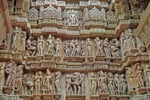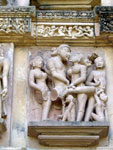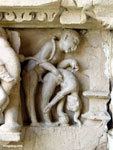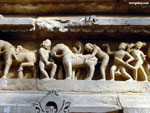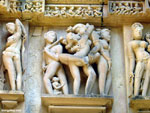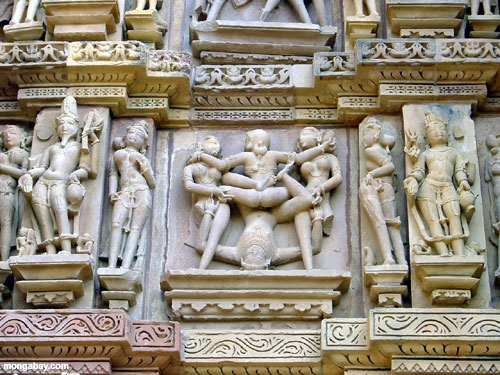India Photos: Kama Sutra Carvings
Last updated: 23 Dec 2022
Sacred and Profane: The Erotic Sculptures of Khajuraho
In the heart of India, in the state of Madhya Pradesh, stand the temples of Khajuraho—an extraordinary testament to medieval Indian artistry. Built between the 10th and 12th centuries by the Chandela dynasty, these temples are renowned not just for their architectural grandeur but for the intricate carvings that adorn their walls. Among them are scenes of a nature that, to the uninitiated, may seem startling: a parade of entwined lovers, celestial nymphs, and acrobatic embraces that appear lifted straight from the Kama Sutra.
For a place of worship, the choice of subject matter seems, at first, perplexing. The temples of Khajuraho are not alone in featuring erotic sculpture—similar motifs appear in the temples of Konark and Sunak—but nowhere else is the depiction as extensive, as exuberant, or as explicit. These carvings have sparked speculation for centuries, inspiring explanations that range from the pragmatic to the mystical.
Interpretations and Theories
The most pedestrian interpretation holds that the temples served as a form of marital education. The Kama Sutra, after all, is not merely a catalogue of carnal positions but a treatise on the art of living, detailing the interplay between pleasure, duty, and spirituality. Some scholars argue that these carvings, positioned prominently on temple exteriors, were designed to instruct young nobles in the pleasures of courtly life. Others see them as a celebration of fertility, a motif common in Hindu and Buddhist art.
More esoteric theories abound. Some claim that the sculptures mark a transition from the mundane to the divine: the exterior of the temple represents worldly existence, with all its sensual temptations, while the inner sanctum signifies spiritual transcendence. By this reading, the visitor must first acknowledge and move past the distractions of the flesh before reaching the divine core within.
There is also a more political explanation. The Chandela rulers, under whose patronage the temples were built, were known for their indulgent courts and appreciation of the arts. Khajuraho flourished at a time when tantric traditions, which saw sexuality as a conduit to higher consciousness, exerted considerable influence in parts of India. The sculptures may well reflect an elite culture that embraced a less prudish approach to pleasure than the later, Victorian-influenced moral codes imposed by colonial rulers.
Rediscovery and Modern Reception
Yet, for all the fascination the temples inspire, their history is one of decline and rediscovery. By the 14th century, Khajuraho had faded into obscurity, abandoned as power shifted to Delhi and later to the Mughal courts. For centuries, the temples were swallowed by the jungle, visited only by wandering ascetics and the occasional local villager. It was not until 1838, when the British engineer T.S. Burt stumbled upon them, that they re-entered public consciousness. Burt, a Victorian officer with the British Army, was reportedly scandalized by the images but meticulous in his documentation, ensuring that the site received due scholarly attention.
Today, Khajuraho is a UNESCO World Heritage site, drawing visitors from across the world. The temples—of which around 25 survive from an estimated 85—remain an enigma, their meaning subject to interpretation and debate. For modern India, they pose an interesting paradox. While the country’s cultural conservatives often decry “Western moral decay,” these 1,000-year-old sculptures stand as a reminder that Indian civilization has, for much of its history, been far more comfortable with human sexuality than its self-appointed guardians would like to admit.
What remains uncontested is the sheer artistic brilliance of the carvings. Each figure, whether engaged in amorous dalliance or poised in divine repose, is a masterwork of balance, movement, and anatomical precision. Their expressions—rapturous, playful, or serene—capture a depth of emotion that transcends time. The temples of Khajuraho are not merely a monument to eroticism; they are a celebration of life in all its complexity, bridging the sacred and the sensual in a way that few cultures have managed since.
A Timeless Legacy
As India hurtles toward modernity, its relationship with its past grows ever more fraught. The temples of Khajuraho stand as a provocative counterpoint to contemporary prudishness, a reminder that long before Freud and Foucault, an older civilization understood that desire and divinity are not necessarily at odds.
More information about this website
These photos are part of my library of 150,000-plus images. Other images may be available beyond those displayed on this page.
To find additional images, you can the Advanced search function at Mongabay to search by country, tag, country-tag combination, etc.
Usage: You are welcome to use this image in presentations or for other purposes provided that you don't remove the watermark. If you are looking to license a high resolution version of the image, contact me.



























